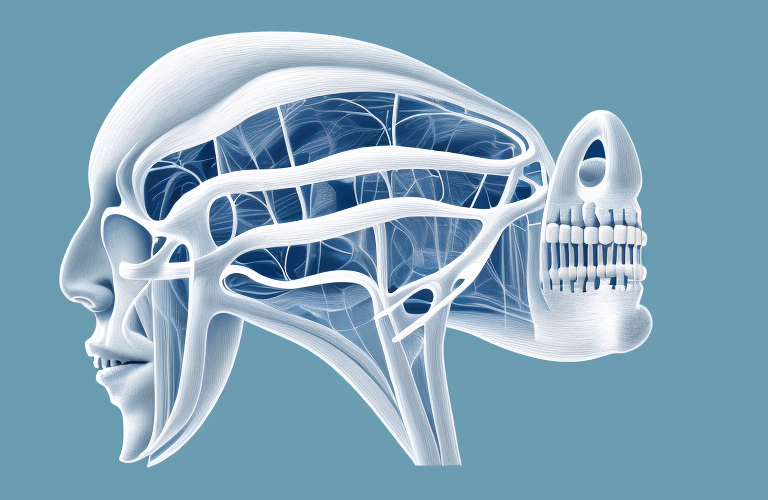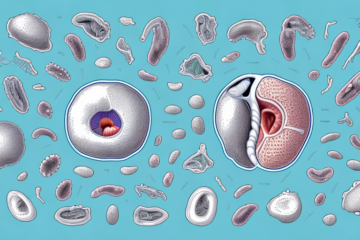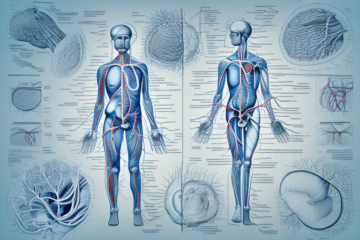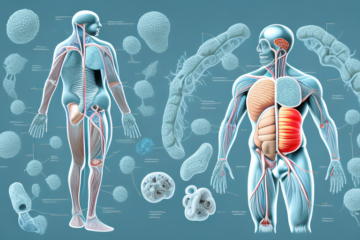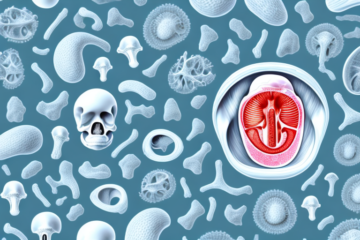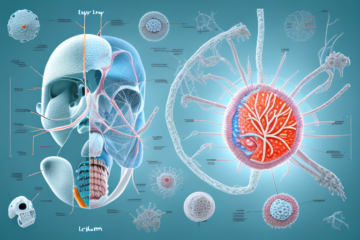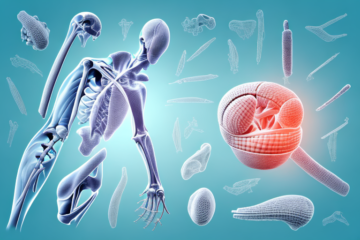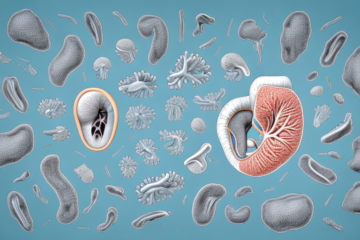The nasal cavity is an important part of the respiratory system that functions to help us breathe, filter air, detect odors, and protect our lower respiratory tract from harmful particles. In this article, we will delve into the anatomy and function of the nasal cavity, and explore various conditions that may affect it.
The Importance of the Nasal Cavity in Breathing
The nasal cavity plays a crucial role in breathing by filtering and warming incoming air, allowing it to reach our lungs in a clean and optimal condition. When we inhale, our nasal cavity captures airborne particles, such as dust, pollen, and bacteria, by trapping them in the mucus lining of the nasal passages.
In addition to filtering and warming incoming air, the nasal cavity also helps to humidify the air we breathe. The moist lining of the nasal passages adds moisture to the air, which is important for keeping our respiratory system healthy and functioning properly. Dry air can irritate the lungs and cause respiratory problems, especially in people with asthma or allergies. Therefore, it is important to keep the nasal cavity hydrated by drinking plenty of fluids and using a humidifier in dry environments.
The Anatomy of the Nasal Cavity: A Detailed Overview
The nasal cavity is a complex structure composed of various bones, soft tissues, and nerve endings. The nasal septum, a cartilage and bone partition that separates the two nostrils, divides the nasal cavity into left and right halves. The turbinates, bony structures covered by mucous membranes, help to warm and moisturize inhaled air as it flows through the nasal passages.
In addition to its respiratory functions, the nasal cavity also plays a crucial role in our sense of smell. The olfactory epithelium, located in the upper part of the nasal cavity, contains specialized cells that detect and transmit odor signals to the brain. This process is essential for our ability to perceive and distinguish different scents.
The Role of Mucus in the Nasal Cavity
Mucus is a viscous fluid that lines the nasal cavity and helps to trap airborne particles, bacteria, and viruses. When we inhale, the particles become trapped in the mucus, preventing them from entering our lungs and causing respiratory infections. Mucus also helps to moisturize and warm inhaled air, making it easier to breathe.
In addition to its protective functions, mucus also contains antibodies and enzymes that help to fight off infections. These substances can neutralize harmful pathogens and prevent them from causing illness.
However, excessive mucus production can also be a symptom of certain health conditions, such as allergies or sinus infections. In these cases, the excess mucus can cause congestion and difficulty breathing. Treatment options may include medications to reduce inflammation or thin the mucus, or in severe cases, surgery to remove blockages in the nasal passages.
The Function of Nose Hair in Filtering Air
Nose hair, also known as cilia, serves as the first line of defense against airborne particles. The hairs prevent larger particles from entering the nasal passages by trapping them on the hair surface. The hairs also move in rhythm with the mucous lining, allowing the trapped particles to be transported to the back of the throat and swallowed, or expelled through sneezing.
In addition to filtering out larger particles, nose hair also plays a role in detecting odors. The hair contains nerve endings that are sensitive to certain chemicals, allowing us to detect and identify different smells.
However, excessive nose hair can also cause problems. It can become a breeding ground for bacteria and viruses, leading to infections. It can also interfere with breathing and cause discomfort. In these cases, trimming or removing the hair may be necessary.
How the Nasal Cavity Helps to Detect Odors
The sense of smell is closely linked to the nasal cavity, which contains specialized cells known as olfactory receptors. The receptors detect various molecules in the air and send signals to the brain, allowing us to perceive different smells and odors.
Interestingly, the olfactory receptors in the nasal cavity are capable of detecting a wide range of odors, including those that are pleasant and those that are unpleasant. This is because the receptors are able to distinguish between different types of molecules, and can identify even the slightest differences in chemical composition.
In addition to detecting odors, the nasal cavity also plays an important role in filtering and humidifying the air we breathe. The nasal passages are lined with tiny hairs called cilia, which help to trap dust, pollen, and other particles that can irritate the lungs. The nasal cavity also contains mucus-producing glands, which help to keep the nasal passages moist and prevent them from drying out.
Common Conditions Affecting the Nasal Cavity: Allergies, Sinusitis, and More
The nasal cavity is prone to various conditions that can affect our breathing and overall health. Allergies, such as hay fever and allergic rhinitis, can cause inflammation of the nasal passages and lead to symptoms like sneezing, itching, and congestion. Sinusitis, an infection or inflammation of the sinuses, can also cause pain, pressure, and nasal congestion.
In addition to allergies and sinusitis, there are other conditions that can affect the nasal cavity. One such condition is nasal polyps, which are noncancerous growths that can develop in the lining of the nose or sinuses. These growths can cause symptoms like congestion, runny nose, and loss of smell. Another condition is deviated septum, which occurs when the wall between the nostrils is crooked or off-center. This can cause difficulty breathing, frequent sinus infections, and nosebleeds.
It is important to seek medical attention if you are experiencing persistent symptoms related to the nasal cavity. Treatment options may include medications, nasal sprays, or in some cases, surgery. Maintaining good nasal hygiene, such as using a saline nasal rinse, can also help prevent and manage these conditions.
The Connection Between Nasal Congestion and Sleep Apnea
Nasal congestion can also contribute to sleep apnea, a condition in which breathing is interrupted during sleep. The narrowing of the nasal passages can obstruct airflow, causing breathing difficulties and snoring. Treating nasal congestion can improve sleep and reduce the symptoms of sleep apnea.
In addition to causing breathing difficulties and snoring, sleep apnea can also lead to other health problems such as high blood pressure, heart disease, and stroke. It is important to seek medical attention if you suspect you may have sleep apnea, as treatment can improve your overall health and quality of life.
How Smoking and Environmental Pollutants Affect the Nasal Cavity
Smoking, as well as exposure to environmental pollutants, can damage the nasal lining and impair respiratory function. The harmful chemicals in cigarette smoke and polluted air can irritate and inflame the nasal passages, leading to chronic sinusitis and other respiratory problems.
In addition to respiratory problems, smoking and environmental pollutants can also affect the sense of smell. The olfactory receptors in the nasal cavity can become damaged, leading to a decreased ability to detect and distinguish different scents. This can have a significant impact on quality of life, as the sense of smell is closely linked to taste and can also serve as a warning for potential dangers, such as gas leaks or spoiled food.
The Differences Between Human and Animal Nasal Cavities
The nasal cavities of various animals, including dogs, cats, and horses, differ in size and shape from those of humans. These differences allow animals to better detect different smells and odors in their environment, while also providing them with more efficient respiratory systems that can withstand higher physical exertion.
For example, dogs have a much larger olfactory bulb in their brains compared to humans, which allows them to process and distinguish between different scents more effectively. Additionally, horses have a unique nasal structure that allows them to breathe through their nostrils even when their heads are lowered, which is important for their survival in the wild.
The Evolutionary History of the Nasal Cavity
The development of the nasal cavity has played a significant role in the evolution of various species. The ability to detect different smells and odors allowed early humans and animals to navigate their environments, locate food, and avoid predators. Over time, the nasal cavity has evolved to provide us with a more efficient respiratory system and a greater sense of smell.
One interesting aspect of the evolution of the nasal cavity is the development of the turbinates. These are bony structures that protrude into the nasal cavity and help to increase the surface area of the nasal mucosa. This allows for more efficient warming and humidification of the air we breathe in, which is important for maintaining healthy lungs.
Another fascinating aspect of the nasal cavity’s evolution is the role it has played in the development of speech. The position and shape of the nasal cavity can affect the way we produce certain sounds, and changes in the nasal cavity over time may have contributed to the development of different languages and dialects.
Surgical Procedures for Treating Nasal Cavity Disorders
In some cases, surgical procedures may be necessary to treat nasal cavity disorders that do not respond to medications or other therapies. The most common surgical procedures include septoplasty, which involves straightening the nasal septum to improve breathing, and endoscopic sinus surgery, which removes blockages and improves drainage of the sinuses.
Another surgical procedure that may be used to treat nasal cavity disorders is turbinate reduction. This procedure involves reducing the size of the turbinates, which are small structures inside the nose that help to warm and humidify the air we breathe. When the turbinates become enlarged, they can block the nasal passages and cause breathing difficulties.
In some cases, surgery may also be used to remove nasal polyps, which are noncancerous growths that can develop in the lining of the nasal passages. This procedure is called a polypectomy and is typically performed using an endoscope, a thin, flexible tube with a camera and light on the end that allows the surgeon to see inside the nasal passages.
Alternative Therapies for Managing Nasal Congestion and Other Symptoms
Various alternative therapies, such as acupuncture, nasal irrigation, and aromatherapy, can help to alleviate symptoms of nasal congestion, allergies, and sinusitis. These therapies may offer a natural, non-invasive approach to treating respiratory problems, while also improving overall health and wellbeing.
In conclusion, the nasal cavity is a complex and essential part of the respiratory system that plays a vital role in our health and overall wellbeing. Understanding its anatomy and function, as well as the various conditions that can affect it, can help us to better manage nasal congestion, improve breathing, and prevent respiratory infections and other health problems.
One alternative therapy that has gained popularity in recent years is the use of essential oils. Certain oils, such as eucalyptus and peppermint, have been shown to have anti-inflammatory and decongestant properties, making them effective in reducing nasal congestion and other respiratory symptoms. These oils can be used in a diffuser, added to a warm bath, or applied topically with a carrier oil.
Another alternative therapy that may be helpful in managing nasal congestion is acupressure. This involves applying pressure to specific points on the body, such as the bridge of the nose or the base of the skull, to relieve congestion and improve breathing. Acupressure can be done by a trained practitioner or learned and performed at home.

